I know that on many occasions I have sung the praises of growing plants from seed, because it's very satisfying fun to do so, but in the interests of fairness and balance, let me kick off this little posting about seeds from the other, grumblier end of the paddock.
Seeds can be frustrating things to work with at times, for various reasons, and out here in Amateur Land I am coming face-to-face with some of those frustrations. Let me explain...
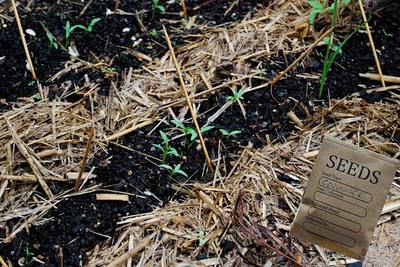 First the good news. The coriander seeds have sprouted. (What's that organic looking brown packet of coriander seeds doing floating in mid-air? Have I discovered levitating seeds? No, it's worse than that. I have discovered Photoshop, and how to make all sorts of dastardly changes to simple, innocent garden photos.) Anyway, back to the seeds... These are seeds I saved from my coriander plants last year, and they're sprouting at the rate of about 60% good 'uns, 40% duds. Not a bad germination rate for an amateur seed-saver. In fact I'm quite proud of the little dears. I have plenty of seeds left over, and I'll be sowing another batch a month or two from now, as coriander is a much better winter crop here in Sydney than it is a summer crop. Lasts for months in winter, does coriander.
First the good news. The coriander seeds have sprouted. (What's that organic looking brown packet of coriander seeds doing floating in mid-air? Have I discovered levitating seeds? No, it's worse than that. I have discovered Photoshop, and how to make all sorts of dastardly changes to simple, innocent garden photos.) Anyway, back to the seeds... These are seeds I saved from my coriander plants last year, and they're sprouting at the rate of about 60% good 'uns, 40% duds. Not a bad germination rate for an amateur seed-saver. In fact I'm quite proud of the little dears. I have plenty of seeds left over, and I'll be sowing another batch a month or two from now, as coriander is a much better winter crop here in Sydney than it is a summer crop. Lasts for months in winter, does coriander.However, that's the first frustration I have with seeds: germination rates. I won't bother showing you the boring little paper pots I have filled with brown potting mix, and no parsley seedlings where there should be parsley seedlings. How about a germination rate of 0%? I know parsley seeds are super-slow to germinate - around three to four weeks is average – but I'm up to five weeks now and not a sausage. Not one! So, all I can do is start again (with a completely different packet of seeds, of course). Next slide please, projectionist!
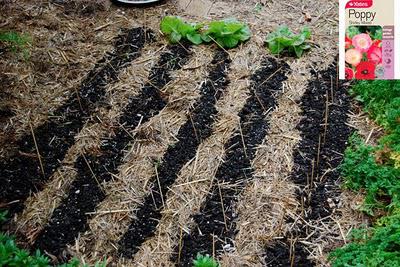 In the top right corner of this pic you can see the packet of the Shirley poppy seeds which I scattered here about five days ago. My Pammy loves poppies, and in previous years I have grown Iceland poppies for her. This year I'm trying Shirleys, which several keen gardeners have strongly recommended for their better colours. The trick with Shirley poppies is that you really do have to grow them from seed, as they hate being transplanted as seedlings. No worries, I can do that. But that's where I have encountered a few more seed-raising issues. See those bamboo skewers poking up out of the ground? They're to stop the pigeons and doves enjoying a dust bath. Any spare patch of bare, dry earth and they're down there spreading their wings (probably trying to get rid of lice, if the truth be known) and making a mess of my neat seed-sowings. They terminated an earlier sowing of parsley seeds with precisely that habit, and so for my Shirleys and other seeds I'm onto them this time.
In the top right corner of this pic you can see the packet of the Shirley poppy seeds which I scattered here about five days ago. My Pammy loves poppies, and in previous years I have grown Iceland poppies for her. This year I'm trying Shirleys, which several keen gardeners have strongly recommended for their better colours. The trick with Shirley poppies is that you really do have to grow them from seed, as they hate being transplanted as seedlings. No worries, I can do that. But that's where I have encountered a few more seed-raising issues. See those bamboo skewers poking up out of the ground? They're to stop the pigeons and doves enjoying a dust bath. Any spare patch of bare, dry earth and they're down there spreading their wings (probably trying to get rid of lice, if the truth be known) and making a mess of my neat seed-sowings. They terminated an earlier sowing of parsley seeds with precisely that habit, and so for my Shirleys and other seeds I'm onto them this time.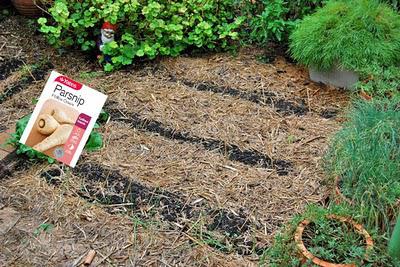 This levitating seed packet of parsnips represents another plant which hates being transplanted and must be grown from seed. I'm having another go at parsnips this year, as my home-growns from two years ago were the sweetest, tastiest, tenderest parsnips I have ever enjoyed. While I know it's the cliche to claim that everything home-grown tastes better than the shop-bought stuff, I really haven't found that to be invariably the case. With tomatoes, definitely yes; parsnips, most assuredly yes; freshly harvested herbs, yes; English spinach, yes; potatoes, yes; citrus yes; garlic, yes.
This levitating seed packet of parsnips represents another plant which hates being transplanted and must be grown from seed. I'm having another go at parsnips this year, as my home-growns from two years ago were the sweetest, tastiest, tenderest parsnips I have ever enjoyed. While I know it's the cliche to claim that everything home-grown tastes better than the shop-bought stuff, I really haven't found that to be invariably the case. With tomatoes, definitely yes; parsnips, most assuredly yes; freshly harvested herbs, yes; English spinach, yes; potatoes, yes; citrus yes; garlic, yes. But for vegies such as carrots, leafy greens, beetroot, shallots, cucumbers, eggplants, silver beet, beans and broccoli the real advantage to me is their tenderness and fresh quality, plus the knowledge that they really, truly have been grown organically. This latter group have never tasted especially superior to the high quality shop-bought, fresh equivalent. I just know mine are healthier. But my home-grown parsnips were a revelation in flavour and tenderness. I want to eat them again!
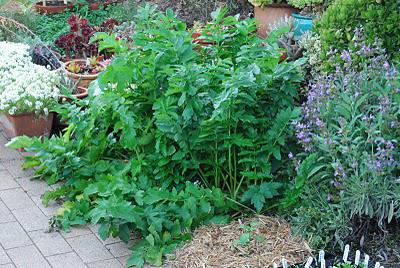 Besides, parsnips aren't a bad looking plant, either. Very nicely green and leafy, and they are part of the garden for a number of months as they slowly grow through the winter. The only problem with getting parsnips started is that even the seed packets suggest you sow the seed thickly, as germination rates are a bit iffy. I can live with that. And I've done the bamboo skewer trick to keep the doves and pigeons away, too.
Besides, parsnips aren't a bad looking plant, either. Very nicely green and leafy, and they are part of the garden for a number of months as they slowly grow through the winter. The only problem with getting parsnips started is that even the seed packets suggest you sow the seed thickly, as germination rates are a bit iffy. I can live with that. And I've done the bamboo skewer trick to keep the doves and pigeons away, too.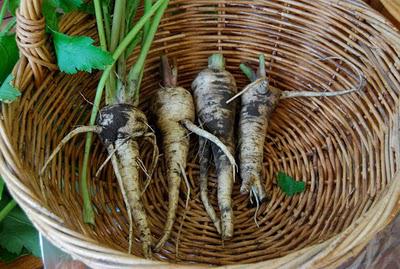 Here's an evening meal's worth of parsnips harvested last time round. One interesting little snippet about my parsnips is that here in Australia at least there aren't all that many varieties to choose from. By far the most popular variety is 'Hollow Crown', and it has been around for generations. It's a bona fide Heritage or Heirloom vegie, but all the major seed suppliers have it too, and it's not marketed as such. The best Yates Seeds (the biggest seed company in Australia) can do is call it a 'traditional favourite'.
Here's an evening meal's worth of parsnips harvested last time round. One interesting little snippet about my parsnips is that here in Australia at least there aren't all that many varieties to choose from. By far the most popular variety is 'Hollow Crown', and it has been around for generations. It's a bona fide Heritage or Heirloom vegie, but all the major seed suppliers have it too, and it's not marketed as such. The best Yates Seeds (the biggest seed company in Australia) can do is call it a 'traditional favourite'. So I don't really have much to grumble about with my seeds. I just hope all that heavy rain we had over the weekend hasn't washed the teeny weeny little poppyseeds away, but the soil there doesn't look too disturbed. I should be seeing some action there maybe next weekend if I'm lucky. But with the parsnip seeds, I'll have to wait. They're every bit as slow as parsley seeds to get going, taking three to four weeks to come up. And that's both the best and the worst bit about seeds: the waiting!
